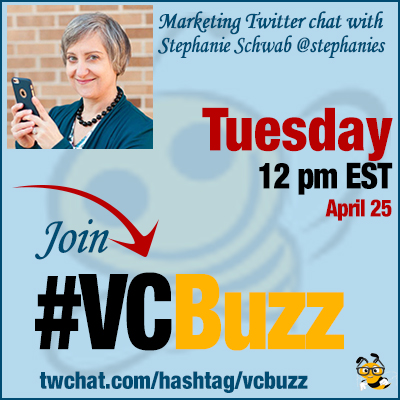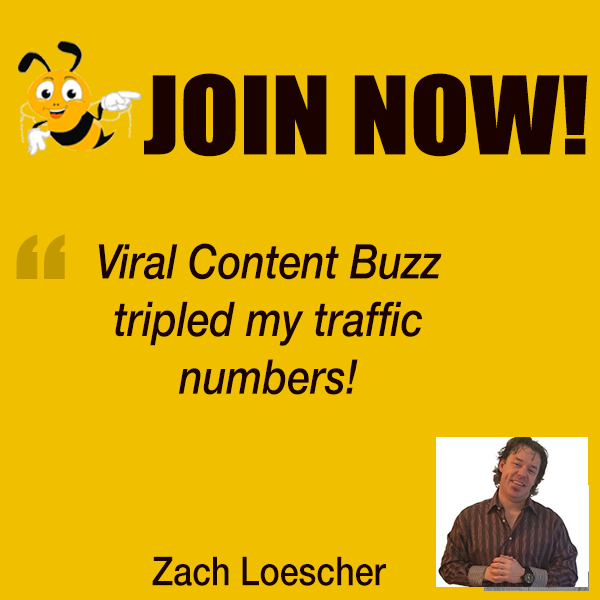 Social media is full of clutter but it doesn’t mean you can say whatever you want there.
Social media is full of clutter but it doesn’t mean you can say whatever you want there.
Your social media presence should be consistent with your brand and reflect your business value. Let’s chat about defining your brand voice today!
***Please sign in here to follow the chat -> twchat.com/hashtag/vcbuzz
About Stephanie
Stephanie Schwab @stephanies is founder of social, content & influence marketing agency Crackerjack Marketing.
Stephanie is a co-founder of Digital Family Summit and an adjunct faculty member at Loyola University’s Quinlan School of Business, where she is the Academic Director of the Digital Marketing Strategy certificate program as well as an instructor on digital marketing topics.
Connect to Stephanie on LinkedIn
Questions we discussed
Q1 How did you become a social media marketer? What’s your career path?
I’ve been in social media marketing for nearly 15 years – a dog’s life in social media!
I came to it from SEO and affiliate marketing, which were forerunners to the content and influence marketing I do today.
I have an MBA in marketing, which is somewhat unusual for a social/digital person, and I worked in management consulting.
I also started a dot-com during the first internet bubble at the end of the last century (!!!)
All of my internet experience, plus consulting, gave me the foundation I need today for my agency work.
Q2 How can a brand find and define their voice online? Why is it important?
Brand voice is not something that just appears, it’s important to take time to craft it. Once you know what your brand voice is, you also must protect it.
I think there are 4 elements of brand voice: Character/Persona, Tone, Language, and Purpose.
You need all 4 for a successful, sustainable voice. Determining these in advance of jumping on social is key to success.
I wrote a post a while back about this, my concept now used in textbooks.
- Character/Persona = who does your brand sound like? can you name a celeb or public figure you want to emulate?
- Tone = Underlying vibe: savvy or clinical; old-fashioned or modern? Helps establish credibility in your space.
- Language= do you sound jargony? Straightforward? Full of slang?
- Purpose = Why are you here? Educate? Entertain? What’s in it for your customer?
Your brand voice need not be the same in all channels, but if it’s not, it should still be consistent within each channel.
It’s key to develop brand voice to differentiate from competitors, establish credibility, and create a sustainable through-line.
If your brand has put time and money into visual branding, it should also put time and money into crafting written voice.
Why wouldn’t you want your brand voice to be as remarkable and memorable as your visuals?
Q3 Are there good examples of brands with strong voice? Please list a few!
Lots of brands have crafted memorable voices in social media.
One of my absolute faves is Denny’s. As my colleague @corijtweets says, they are off the hook on Tumblr. Denny‘s also breaks the norms on Twitter -lowercase, no links, kind of crazy. However, on Facebook, Denny’s is more middle-America, appealing to an older demographic.
Denny’s is a great example of how to have consistent, but different, voices in various channels. Appeals to millennials in Twitter & Tumblr, older demo in Facebook, really different but carefully crafted in each channel.
Another brand I love in social is Burt’s Bees. Their voice is pretty much the same across all channels. Burt’s Bees is playful but very helpful. Super consistent in terms of tone, language, images. Burt’s Bees is similar on Twitter (only shorter).
A good B2B example is GE – they are very human for a tech/industrial company, and place a big emphasis on their team.GE on Twitter – @generalelectric; GE on Instagram. GE makes otherwise complex topics easy-to-understand, yet they don’t talk down to their followers.
If you know TV chef Alton Brown, you know that his Twitter feed sounds just like he does on TV. Making your voice sound the same online as it does offline can be very important for some brands/personalities.
Q4 How has online branding evolved over time? What’s the most exciting trend you’ve seen?
Online branding has evolved so much since the days when you could setup a Twitter account and have 1,000 followers in a month.
Social media is definitely not “free,” it’s something you must invest in.
In order to succeed, brands must stand out amongst competitors, create a social strong platform for the brand.
What’s exciting is the new platforms emerging, and new ways to use old ones, like Instagram Stories. Creative brands don’t necessarily chase the latest shiny social platform, but make the best use of new features & functionality.
I love seeing web-only, primarily social brands like ColorPop Cosmetics. ColorPop’s mission is to make budget-friendly products that appeal to instagrammers and other influencers – a very social brand.
I’m also really interested in the intersection of brands & influencers, as I’m writing a book on influence marketing. Influence marketing is changing so rapidly with advent of new platforms (such as Snapchat) and brand use of microinfluencers.
A4: If any of you are influencers or brands working with influencers, get in touch – I'd love to hear your stories! #vcbuzz
— Stephanie Schwab (@stephanies) April 25, 2017
Q5 What are your favorite social media marketing tools for businesses and why?
Tools! As our agency is a virtual agency – everyone works out of their own home – we use tools to keep us connected & organized.
My colleagues @corijtweets, @mrsstrick & @Lesley_Lloyd wrote a great post about our tools here.
This cool business name generator will help you pick a cool brand name which will be easily to market!
We use @slackHQ for our day-to-day, love the archive and search feature. We have a channel for “cool tools” to share the latest.
We also rely heavily on @TheSocialReport for client reporting, but also evergreen content scheduling. What we love about it are the beautiful charts we can use in client reporting.
For Instagram, we use Grum to schedule posts – very difficult to find a good tool to do that.
On the web or via mobile for Instagram publishing? Paid Instagram content as well? #vcbuzz
— Erica Jenkins (@e_jenkins77) April 25, 2017
Grum allows for web-based Instagram publishing – I’m pretty sure organic only. We only use for organic.
We also have our own version of an Editorial Calendar, which is our bible for each client, all content goes in there.
A5: Our EdCal is free on our website – it's a Google Sheet anyone can use and modify: https://t.co/KHXzRKfiDd #vcbuzz
— Stephanie Schwab (@stephanies) April 25, 2017
We’ve also been using @hootsuite since their earliest days, a huge help to manage multiple clients and multiple users.
Back to concept of social media not being free – it’s worth investing in quality tools to streamline your social workload. And being organized in social is one of the keys to having a consistent brand voice.
A5: Are any of you also @SlackHQ users? Do you find, as we do, that it cuts down on email volume? #vcbuzz
— Stephanie Schwab (@stephanies) April 25, 2017
@stephanies I like that @SlackHQ integrates with @Trello. I'll be using it more in an upcoming project. #vcbuzz
— Lori Tian Sailiata (@LaraBrittWrites) April 25, 2017
https://twitter.com/jessytroy/status/856913367142989824
If you have all content in an EdCal, it’s easy to see voice carry through channel(s), & easy for team to collaborate.
I will! Shooting for summer. RT @LaraBrittWrites: @stephanies Please let us know when your book comes out. #vcbuzz
— Stephanie Schwab (@stephanies) April 25, 2017




Leave a Reply